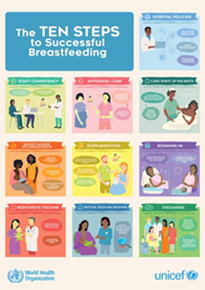Ten steps to successful breastfeeding (revised 2018)

WHO and UNICEF launched the Baby-friendly Hospital Initiative (BFHI) to help motivate facilities providing maternity and newborn services worldwide to implement the Ten Steps to Successful Breastfeeding. The Ten Steps summarize a package of policies and procedures that facilities providing maternity and newborn services should implement to support breastfeeding. WHO has called upon all facilities providing maternity and newborn services worldwide to implement the Ten Steps.
The implementation guidance for BFHI emphasizes strategies to scale up to universal coverage and ensure sustainability over time. The guidance focuses on integrating the programme more fully in the health-care system, to ensure that all facilities in a country implement the Ten Steps. Countries are called upon to fulfill nine key responsibilities through a national BFHI programme:
Ten steps to successful breastfeeding
Critical management procedures
1a. Comply fully with the International Code of Marketing of Breast-milk Substitutes and relevant World Health Assembly resolutions.
1b. Have a written infant feeding policy that is routinely communicated to staff and parents.
1c. Establish ongoing monitoring and data-management systems.
2. Ensure that staff have sufficient knowledge, competence and skills to support breastfeeding.
Key clinical practices
3. Discuss the importance and management of breastfeeding with pregnant women and their families.
4. Facilitate immediate and uninterrupted skin-to-skin contact and support mothers to initiate breastfeeding as soon as possible after birth.
5. Support mothers to initiate and maintain breastfeeding and manage common difficulties.
6. Do not provide breastfed newborns any food or fluids other than breast milk, unless medically indicated.
7. Enable mothers and their infants to remain together and to practise rooming-in 24 hours a day.
8. Support mothers to recognize and respond to their infants' scues for feeding.
9. Counsel mothers on the use and risks of feeding bottles, teats and pacifiers.
10. Coordinate discharge so that parents and their infants have timely access to ongoing support and care.
Source: https://www.who.int/nutrition/bfhi/ten-steps/en/